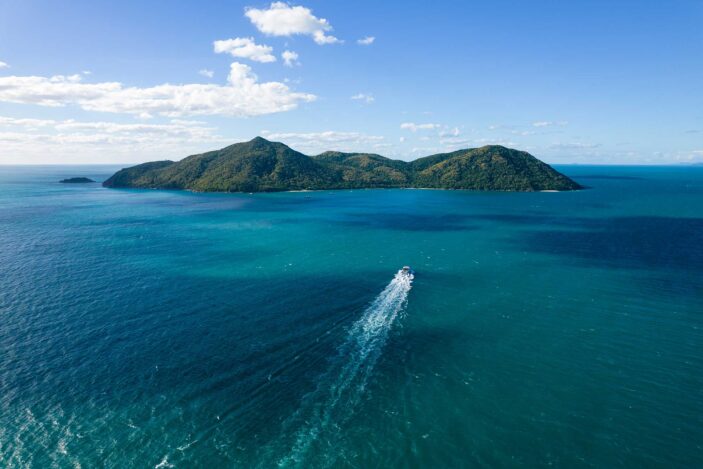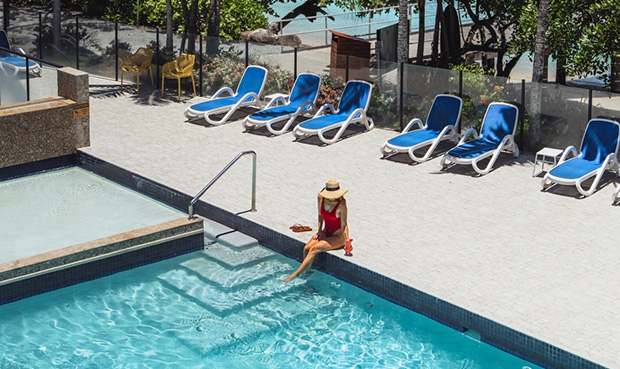Fitzroy Island is a tropical paradise located off the coast of Cairns, Queensland, Australia. This stunning island boasts crystal-clear waters, vibrant coral reefs, and lush rainforests, making it a popular destination for tourists and locals alike. However, beyond its natural beauty, Fitzroy Island also has a rich cultural and historical significance that is important to understand and appreciate.
The island has a long history of Indigenous ownership and occupation by the Gimuy Walubara Yidinji people, who have a deep spiritual and cultural connection to the land. In addition, Fitzroy Island played a significant role in European exploration and settlement, serving as a quarantine station and naval defence outpost during World War II.
As Fitzroy Island continues to evolve and be utilised as a tourist destination and National Park, it is crucial to recognize and preserve its cultural and historical significance. This article will explore the island’s past and present, highlighting the importance of understanding its rich cultural and historical heritage.
A Spiritual Connection: The Yidinji People’s Deep Ties to Fitzroy Island
Fitzroy Island has a deep and important Indigenous history, being the traditional land of the Gimuy Walubara Yidinji people for over 9,000 years. The Yidinji people have a strong spiritual and cultural connection to the island, which they call Koba or Gabar, and consider it to be a place of significant cultural importance.
For the Yidinji people, Fitzroy Island is a place where they have traditionally conducted important ceremonies, such as initiation rites for young men, and where they have gathered food and medicine from the land and sea. The island is also believed to be the home of a significant ancestor spirit, Djugun, who is said to have created the landscape and left behind his spiritual essence in the land and sea.
Throughout the 19th and early 20th centuries, European explorers and settlers interacted with the Yidinji people on and around Fitzroy Island. These interactions were often fraught with tension and conflict, as European settlers encroached on Yidinji land and disrupted traditional ways of life. Despite this, some Yidinji people also found work and opportunities through interaction with European settlers, such as employment in the fishing and pearling industries.
Today, the Yidinji people continue to advocate for the recognition and preservation of their cultural and historical connection to Fitzroy Island, working alongside the Queensland Parks and Wildlife Service and other stakeholders to ensure that the island’s heritage is protected and respected.
Fitzroy Island’s Early Days: A Story of European Contact and Dispossession
European exploration and settlement of Fitzroy Island began in the late 18th century, with the arrival of Captain James Cook during his 1770 voyage along the east coast of Australia. Cook named the island after Augustus FitzRoy, a British naval officer and politician who served as governor of New South Wales from 1846 to 1855.
Following Cook’s visit, European settlement on Fitzroy Island began in the mid-19th century, with the establishment of a pilot station and lighthouse on the island’s eastern point. This was followed by the construction of a quarantine station in the late 19th century, which was used to isolate people with infectious diseases, particularly during the smallpox outbreaks of the late 1800s and early 1900s.
Unfortunately, European settlement had a massive impact on the island’s environment and Indigenous communities. The construction of infrastructure and introduction of non-native flora and fauna caused widespread ecological damage, and the dispossession of Indigenous lands and displacement of Yidinji people disrupted traditional practices and cultural heritage.
Today, the remnants of European settlement can still be seen on Fitzroy Island, with the lighthouse and other historic buildings preserved as important cultural and historical sites. However, ongoing efforts are being made to restore and protect the island’s environment and to work collaboratively with the Yidinji people to recognise and preserve their cultural heritage.

Fitzroy Island During the War: A Strategic Outpost in the Pacific
During World War II, Fitzroy Island played a significant role as a naval defence outpost for the Australian military. The island’s strategic location made it an ideal location for surveillance and defence against potential enemy attacks. A number of military structures were constructed on the island, including gun emplacements, searchlight stations, and bunkers.
The impact of the war on the island’s environment and infrastructure was significant. The construction of the radar station and other military facilities led to the clearing of large areas of rainforest and damage to coral reefs, which has had lasting effects on the island’s ecosystem. The military occupation also led to changes in the island’s social and cultural fabric, as many Yidinji people were forced to leave their homes and traditional lands.
After the war ended, Fitzroy Island was abandoned by the military, and the infrastructure fell into disrepair. The impact of the war on the island’s environment and infrastructure continued to be felt for many years, with ongoing efforts required to restore and rehabilitate the island. The island was later used for various purposes, including as a holiday resort and research station, before being declared a National Park in 1978.
Today, Fitzroy Island’s military history is remembered through a number of memorials and historical displays scattered throughout the island. The remnants of the military infrastructure, such as gun emplacements and underground tunnels, provide a glimpse into the past and serve as a reminder of the island’s important role in Australia’s history.
Fitzroy Island’s Significance in Modern Times
Fitzroy Island is now a popular tourist destination and National Park, attracting visitors from all over the world who come to experience its stunning natural beauty and rich cultural heritage. As a National Park, the island is managed by the Queensland Parks and Wildlife Service, who are responsible for preserving and protecting its unique ecosystem and cultural heritage.
The cultural and environmental significance of Fitzroy Island cannot be overstated. The island is not only a place of great natural beauty but also a site of deep cultural importance for the Yidinji people. It is essential to ensure that the island’s cultural and environmental heritage is preserved for future generations to enjoy and appreciate.
Efforts are being made to protect and educate visitors about Fitzroy Island’s cultural and historical significance. This includes cultural tours and experiences led by Yidinji traditional owners, as well as educational displays and interpretive signs throughout the island. The aim is to provide visitors with an opportunity to learn about and appreciate the island’s rich cultural and natural heritage.
Furthermore, Queensland Parks and Wildlife Service and the traditional owners of the land, the Gimuy Walubara Yidinji people, are working together to promote sustainable tourism on the island, ensuring that tourism activities do not have a negative impact on the island’s ecosystem and Indigenous heritage. This includes measures such as waste reduction and management, sustainable development practices, and minimizing visitor impacts on sensitive areas.
Through these efforts, hopefully, the cultural and environmental significance of Fitzroy Island will continue to be recognized and celebrated, ensuring its status as a unique and important site of national heritage for generations to come.

Fitzroy Island: A National Treasure Worth Protecting
As Fitzroy Island continues to evolve and thrive as a tourist destination and National Park, it is crucial that we recognize and appreciate the island’s unique cultural and environmental heritage. We should learn more about the island’s past and the ongoing efforts to protect and preserve it, ensuring that its beauty and significance can be enjoyed by generations to come.
If you’re looking for an opportunity to explore Fitzroy Island’s rich history and culture, Fitzroy Island Resort offers a range of cultural and natural experiences. From guided tours and Indigenous cultural experiences to snorkelling and hiking tours, there are plenty of ways to appreciate the island’s unique beauty and significance.
Let’s work together to appreciate and preserve this island’s unique heritage, ensuring that its significance is celebrated for many years to come.





